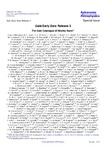Gaia Early Data Release 3: The Gaia Catalogue of Nearby Stars

Use este enlace para citar
http://hdl.handle.net/2183/28480Coleccións
- Investigación (FIC) [1605]
Metadatos
Mostrar o rexistro completo do ítemTítulo
Gaia Early Data Release 3: The Gaia Catalogue of Nearby StarsAutor(es)
Data
2021Cita bibliográfica
R. L. Smart et al., «Gaia Early Data Release 3 - The Gaia Catalogue of Nearby Stars», A&A, vol. 649, p. A6, may 2021, doi: 10.1051/0004-6361/202039498
Resumo
[Abstract] Aims. We produce a clean and well-characterised catalogue of objects within 100 pc of the Sun from the Gaia Early Data Release 3. We characterise the catalogue through comparisons to the full data release, external catalogues, and simulations. We carry out a first analysis of the science that is possible with this sample to demonstrate its potential and best practices for its use.
Methods. Theselection of objects within 100 pc from the full catalogue used selected training sets, machine-learning procedures, astrometric quantities, and solution quality indicators to determine a probability that the astrometric solution is reliable. The training set construction exploited the astrometric data, quality flags, and external photometry. For all candidates we calculated distance posterior probability densities using Bayesian procedures and mock catalogues to define priors. Any object with reliable astrometry and a non-zero probability of being within 100 pc is included in the catalogue.
Results. We have produced a catalogue of 331 312 objects that we estimate contains at least 92% of stars of stellar type M9 within 100 pc of the Sun. We estimate that 9% of the stars in this catalogue probably lie outside 100 pc, but when the distance probability function is used, a correct treatment of this contamination is possible. We produced luminosity functions with a high signal-to-noise ratio for the main-sequence stars, giants, and white dwarfs. We examined in detail the Hyades cluster, the white dwarf population, and wide-binary systems and produced candidate lists for all three samples. We detected local manifestations of several streams, superclusters, and halo objects, in which we identified 12 members of Gaia Enceladus. We present the first direct parallaxes of five objects in multiple systems within 10 pc of the Sun.
Conclusions. We provide the community with a large, well-characterised catalogue of objects in the solar neighbourhood. This is a primary benchmark for measuring and understanding fundamental parameters and descriptive functions in astronomy.
Palabras chave
Catalogs
Astrometry
Stars: luminosity function, mass function
Hertzsprung-Russell and C-M diagrams
Stars: low-mass
Solar neighborhood
Astrometry
Stars: luminosity function, mass function
Hertzsprung-Russell and C-M diagrams
Stars: low-mass
Solar neighborhood
Versión do editor
Dereitos
© ESO 2021





